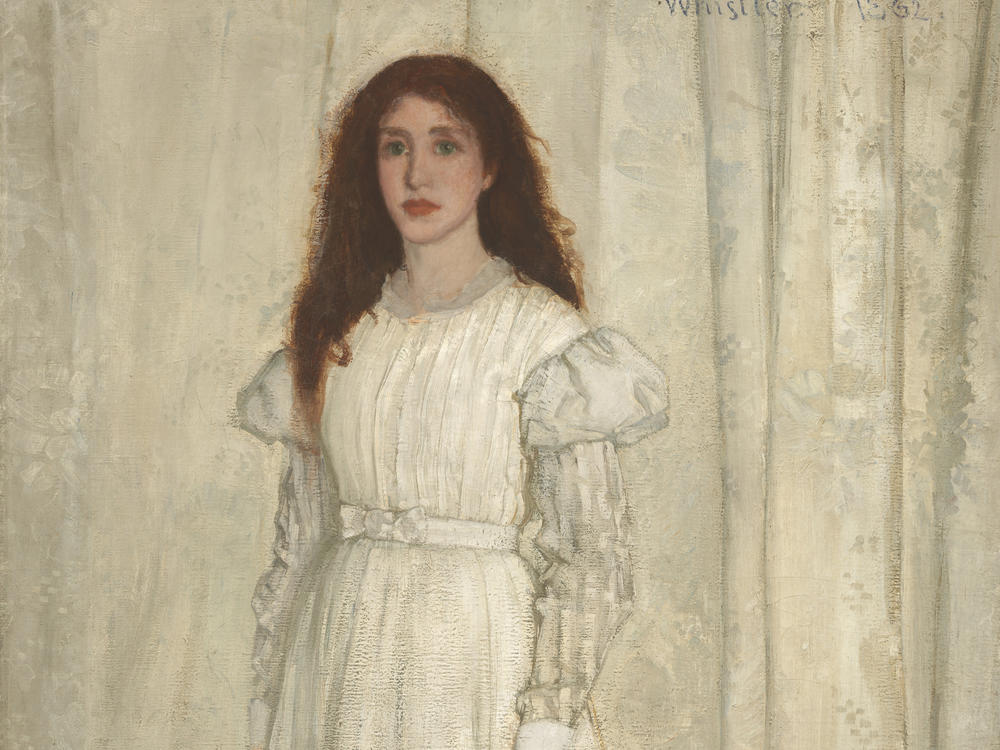Section Branding
Header Content
Whistler's Mother, meet Whistler's very, very close friend at the National Gallery
Primary Content
An early painting by 19th century American artist James McNeill Whistler is the focus of an exhibition at Washington D.C.'s National Gallery of Art. The big and fascinating show does not feature his most famous work — a picture of Whistler's closest relative: his formidable mother.
I've known Whistler's Mother for years. So do you, if you've ever had an art class, or seen a book of art classics. Old lady in profile, wearing a really black dress, white lace cuffs, white bonnet, sitting by a gray wall. Mean looking. Judgmental.
Click here to meet Anna McNeill Whistler.
This exhibition — "The Woman in White: Joanna Hiffernan and James McNeill Whistler" — is about the artist's relationship with a much younger woman. He painted her 10 years before his mother.
Hiffernan was Whistler's model, muse, and more. But did Muse and Mom know each other?
"Oh yes!" says curator Margaret MacDonald, who unearthed new information about the model. She says Mama didn't seem to think much of Joanna. "She was a bit dubious about models. The danger of a model possibly being seduced made her not respectable."
Victorian morals. Were they lovers? "Oh yes! Absolutely."
Joanna Hiffernan may not have been too crazy about Anna McNeill Whistler with good reason. Hiffernan lived with James Whistler "until Mother came, and she had to move out," MacDonald says. Still, model and artist continued their relationship for decades. Hiffernan ran his studio, kept track of the books, even raised a son Whistler had with another woman.
Letters and diaries show Joanna Hiffernan to have been great company, says MacDonald. "She was passionate, had a quick temper, was quite funny," she says. "She was jolly."
Whistler painted and sketched and etched his muse again and again. The National Gallery exhibits three paintings of Hiffernan in white.
In Symphony No. 1; the White Girl, she's larger than life, with long red hair. (X-rays show Whistler fooled around with the length.) She wears a long white dress. (Lots of laundresses in 1861). She's standing on a polar bear rug. (Stylish, then, in middle class homes). A distant gaze in her eyes, staring into space.
In Symphony In White No. 2: the Little White Girl, she's still dreamy, still wearing white. Proper lady, with a nice mantlepiece!
In Symphony in White No. 3, she's got company. Two lovely women in white. Maybe having a heart-to-heart.
What's with those titles? Well, the famous painting of Whistler's Mother is officially called Arrangement in Grey and Black. He was exploring variations in those colors, how they sat together, echoed one another. He's doing the same thing in his Symphonies. Whistler's white wasn't just white. He mixed several colors into it. "So it had a warmth," MacDonald explains. "It isn't cold white."
Painters like working with white. Nice texture. Fun to use.
"Whistler got a big brush, got enough paint on it, and slams is down like a mosaic of colors. It all feels good. If you're an artist, you enjoy that!" she says.
So do art lovers. Although Joanna Hiffernan wrote a friend about some 19th century reactions to Whistler's Symphony No. 1, the centerpiece of the National Gallery's exhibition: "The White Girl has made a great sensation, for and against. Some stupid painters don't understand it at all. The old duffers may refuse it altogether."
And they did. But not for long!
Copyright 2022 NPR. To see more, visit https://www.npr.org.

